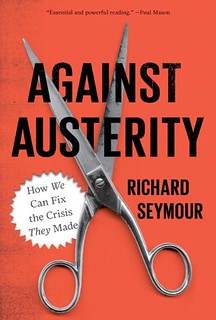Sunday, April 13, 2008
It's bad for you. posted by Richard Seymour
The warnings about soaring global food prices are just flooding in. From the IMF riot to the food riot. Aside from causing starvation among large swathes of consumers, fluctuations in global commodity prices typically wreak the most havoc for small producers. Multinationals and agricommerce don't have this problem, because they are diversified and have the resources to wait out slumps or spirals. While the chaos resulting from the subordination of basic human requirements to global markets can cause social collapse, an erosion of the moral geography, and intensified social conflict of the kind that has afflicted Sudan and pre-genocide Rwanda, the people who are meant to make money from it keep making money from it. Currently, the emphasis on biofuels and the shift of investors away from bad bets in subprime to staple goods have conspired to drive the prices up. So, although there is more than enough rice to meet every individual's dietary requirements, we are told there is a 'scarcity'. That's capitalism for you: even where's plenty, there ain't enough.In light of all this, I have some questions. To wit: what is that shit you're eating? Why are you so fat, yet malnourished? Why is it that for the first time the number of obese people (1 billion) exceeds the number of starving people (850 million)? And how are those two facts related? Answer come later. The basic facts of starvation are reasonably well known. In the nineteenth century, the world champions of famine were India and China, both subjects of colonial exploitation. India suffered on average a million famine-related deaths a year in the last quarter of the twentieth century. China suffered several severe bouts of famine, costing between 9.5 million lives and 13 million lives in 1877-8, and a further million lives in 1892-4. In the 1877-8 famine, some prefectures saw 95% of the population die. Mike Davis describes in Late Victorian Holocausts how these were a part of a global wave of synchronised hunger of unprecedented savagery, coterminous with the high point of colonial repression and the subordination of much of the planet to capitalist imperatives for the first time. There had been famines in previous millenia, a combination of natural catastrophe and social failure. But nothing like this had ever occurred before. Both India and China defeated famine due to developmentalist policies since the mid-20th Century, even if the recent introduction of neoliberalism has put this outcome in question. The provisions in India's post-colonial Scarcity Manuals, Alex de Waal points out in Famine Crimes, have prevented the descent to epidemic starvation at several key moments - he cites the 1970-3 drought relief response in Maharashtra, which "stands as a model of effective famine prevention by utilizing the provisions of the Scarcity Manuals to the full".
China did suffer one appalling famine in 1959-61, with mortality estimates ranging from 15 million (the Chinese government's figure) to 43 million (the figure reached by the reformist Chinese economist Chen Yizi). The reasons for this, as one would expect, are as much political and economic as natural. The sudden, drastic changes in property forms and incentives associated with the catastrophic 'Great Leap Forward' dramatically reduced output, while at the same the government was appropriating grain for mass export to pay debts to the Soviet Union. Nonetheless, barring that atrocious failure, China did fundamentally depart from its at least century old status as the 'land of famine'. It raised life expectancy all round as a result of social protection systems. In one comparison Amartya Sen and Jean Dreze noted that "India seems to manage to fill its cupboard with more skeletons every eight years than China put there in its years of shame" because of the former's lack of of social protection. (In connection with this debate, you might wish to check out Mobo Gao, the anthropologist and left-Maoist critic of Dengism, who argues that the 'Great Leap Forward' notwithstanding, the Mao years were beneficial for rural China. His latest book also takes to task Jung Chang and Jon Halliday's sensationalist account of the Mao years with some convincing arguments.) At any rate, in South Asia today, mass famine is not the pervading reality it once was, although it remains a risk in North Korea, Bangladesh and Cambodia for different reasons. This is because starvation is not a naturally occurring phenomenon, but the result of a particular political economy. The fact that 6.6m children starve to death each year is no accident of the weather.
Well, then, given that starvation is a historical and not natural phenomenon, given that struggle has proven that we have the technology and political capacity to prevent it, why is it so persistent? Why should the problem of malnourishment and mortality from starvation be getting worse when the technical means to deal with it are more abundant now than ever before? The best answer to these questions to date has been supplied by the former World Bank employee and UN consultant Raj Patel in his justly praised Stuffed and Starved. First of all, let's go back over obesity for a moment. Obesity is related to a bunch of other health problems, such as cardiovascular disease and diabetes. Both obesity and diabetes among the poorest citizens of advanced capitalist societies are shooting through the roof, while India and China are today the world leaders in cardiovascular disease, and childhood obesity is increasing rapidly in China as the market is opened to Western food producers. New Labour, when it gets in the mood, likes to exhort us to be healthier in our dietary choices. This might even be useful as general advice, but in the government's case it functions as a kind of apologia for its neoliberal policies by placing the emphasis on individual choice, when the individual has precious little of it. To the extent that it is treated as a social issue, it is a means by which the poorest population groups are stigmatised - it becomes the basis for moral panic. Sometimes, it becomes infotainment, the stuff of satirical muck-raking and exposé. But the dietary restructuring of the average human being in late capitalism is not merely the result of poor choices, misleading advertising or the spread of certain corporations. And obesity can no more be the object of moral reproach than starvation. So, here is the answer to questions one and two above: the shit you're eating is likely to be high in sugar and fat, because that is what is most likely to be on offer, especially if you live in a poor area of the developed capitalist countries and especially if you're black in America. The supermarket industry is particularly responsible for this state of affairs, and it mirrors the segregated dimensions of poor health related to malnutrition in the US. Firstly, by freezing out smaller producers of fresh fruit and vegetables, thus depriving consumers of choice beyond those adopted by the supermarket for its own convenience; secondly, by 'red-lining' poor African-American or Hispanic neighbourhoods and refusing to set up branches in them, so that residents are left with a limited range of foods such as corn dogs and frozen pizza, high in saturated fat; thirdly, where they do set up in black neighbourhoods, they systematically stock lower quality foods; and finally, they charge higher prices to poorer urban consumers, so that they can buy less of the shit that is available. The global food industry is structured in such a way that urban workers in rich capitalist societies are more and more likely to be offered an inferior range of high fat, high sugar foods, with more places to consume alcohol and fewer food markets with a poorer range of products. As usual, America's fat can bears a lot of the blame: even if you happen to live near the US (ie, if you're a Mexican family living just south of the border), your chances of suffering from health conditions adjoining obesity with malnourishment are increased. It isn't an accident of geography: if you're working class, this is how you're expected to get by. High-energy food is an important component in the reproduction of labour, and is particularly handy if quick to cook or pre-cooked. Alcohol provides a sort of self-medication for the stress and boredom and growing depression that most people are subject to. The all-too-brief sense of warmth and well-being is also an ideal social lubricant among workmates. All of these factors help produce larger frames with more body fat, even while you get a sub-standard nutritional intake. Among those who manage to avoid piling on adipose layers may be the 35.1 million Americans who don't know where their next meal is coming from because production is organised according to market principles that recognise no human need, but only demand backed up by purchasing power.
Of course, the way in which the extension of these market principles has been encouraged by the IMF among others has added to the ranks of the impoverished in various ways. India's 'Green Revolution', just as much as China's neoliberalism, is responsible for removing social protections for small producers; enclosing the land for capital; ruining whole swathes of the population by pushing them into the red; generating a landless proletariat with few prospects who can flee to overcrowded urban areas or try to eke out an existence in former rural communities; and creating a quite remarkable rise in the rate of rural suicide. Well, actually, rural life is tough all around - suicides are higher among farmers than any other economic group in the UK. Sadly, their main champions are puce-faced right-wing bigots who should have their farms expropriated and nationalised. One of the few challenges to this trend, Brazil's landless workers' movement (the MST) is perceived as a mortal threat by the food industry. Where they succeed, for example, McDonalds may end up having to pay more to its suppliers for the soy beans it uses in the McNuggets that you're stuffing your face and padding your ass with. They will keep more land to work as cooperatives, and those cooperatives won't be producing soy, because it isn't economically viable for them to do so. McDonalds gets less profit if Cargill has to withdraw from its Brazilian plantations, take down its illegal port and find somewhere else to monoculture the fields. That is un-American. Besides, the MST's ecological concerns and socialistic doctrines obstruct capitalist practise - that land should ideally be owned by an oligarchy that extracts maximum profits by providing the cheapest possible labour working on one big export product. Of course, by turning food production into an export-led industry while allowing most of the profits to be siphoned out of the country, you do run the risk of leaving large numbers of people impoverished and malnourished in Brazil. And in Brazil, a body broken by poverty will process fat rather badly and potentially end up obese even without eating a large amount of food. But at least that means that you can have several high-fat, high-sugar meals in your local fast food outlet every day. It doesn't even have to be McDonalds. The smaller the store, the more likely it buys in the cheapest meat with the most additives and the least nutritious value from probably the same people that sell the slightly better quality stuff to the big chains. So, that answers question number three. Sure, people starve. Sure, it's poor quality food. Sure, there's shit in the burger. But isn't that life? No, that's capitalism: it's full of shit and its bad for you.
Labels: capitalism, colonialism, fast food, food industry, food prices, malnutrition, neoliberalism, starvation










